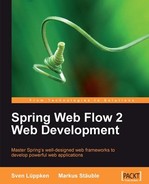Book Description
Master Spring's well-designed web frameworks to develop powerful web applications
About This Book
- Design, develop, and test your web applications using the Spring Web Flow 2 framework
- Enhance your web applications with progressive AJAX, Spring security integration, and Spring Faces
- Stay up-to-date with the latest version of Spring Web Flow
- Walk through the creation of a bug tracker web application with clear explanations
Who this book is for
This book is targeted at Java web application developers who want to work on Spring Web Flow. This book is a must-read for those who desire to bridge the gap between the popular web framework and the popular application framework. It requires prior knowledge of the Spring framework, but no prior knowledge of Spring Web Flow.
What You Will Learn
- Explore the features of Spring Web Flow 2 to develop powerful applications
- Extend the framework to take it beyond its out-of-the-box feature set
- Get started with Spring Faces, Spring JavaScript, and Spring Binding and improve the handling of the web flow
- Test your Spring application and rest assured of its quality before going live
- Secure your web applications using Spring Security and Spring Web Flow
- Integrate JavaServer Faces (JSF) with Spring Web Flow to organize and manage the storage of data inside your web application
In Detail
Many web applications need to take the user through a defined series of steps such as e-commerce checkouts or user registrations. Spring Web Flow works well for rich and flexible user interaction, additionally it helps you to describe the flow of websites in complex processes. Spring Web Flow 2 provides the perfect way to build these kinds of features, keeping them secure, reliable, and easy to maintain.
This book provides a platform on which you can build your own applications and services. It gives detailed information on Spring basics and covers core topics involving testing, security, and so on. We develop a complete, robust web application using the latest version of Spring, where page navigation is done on-the-fly.
This book teaches you how to work with Spring Web Flow. It covers both basic and advanced aspects and provides a detailed reference of the features Spring Web Flow. The book helps readers to extend the framework.
The integration of Spring and Java Server Pages is clearly explained in the book. The book also explains the essential modules of the complete Spring framework stack and teaches how to manage the control flow of a Spring web application.
The Spring Faces module will provide integration between Spring Web Flow and Java Server Faces (JSF). Testing, an important aspect of the software development process is covered towards the end; the question of how to test a Spring Web Flow application is answered.
A practical guide to designing powerful web applications with the Spring Web Flow framework
Style and approach
This book is a tutorial, with plenty of step-by-step instructions beginning with "getting started" material, followed by advanced coverage of this technology. The book has a practical approach towards the Spring MVC framework and is packed with practical examples and code.
Downloading the example code for this book You can download the example code files for all Packt books you have purchased from your account at http://www.PacktPub.com. If you purchased this book elsewhere, you can visit http://www.PacktPub.com/support and register to have the files e-mailed directly to you.
Table of Contents
- Spring Web Flow 2 Web Development
- Credits
- About the Authors
- About the Reviewers
- Preface
- 1. Introduction
- 2. Setup for Spring Web Flow 2
- 3. The Basics of Spring Web Flow 2
- Elements of a flow
- Configuration
- The complete flow for the example
- Summary
- 4. Spring Faces
- 5. Mastering Spring Web Flow
- 6. Testing Spring Web Flow Applications
- 7. Security
- A. flow.trac:The Model for the Examples
- B. Running on the SpringSource dm Server
